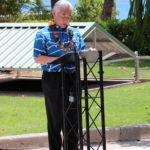Yesterday, on the 30th anniversary of World Oceans Day, Governor Ige signed four measures related to the protection of aquatic resources into law.
In remarks at the Kupu Hoʻokupu Center at Kewalo Basin, the governor said the new laws reflect the legislature’s earnest and continuing efforts to provide further ocean protections across the state.
The bills include:
- authorization of a pilot carrying capacity study for the Pūpūkea Marine Life Conservation District on O‘ahu’s North Shore;
- establishment of tiered administrative fines to strengthen penalties for aquatic resource violations;
- funding for fish aggregation devices; and
- authorization for the use of in-lieu fee mitigation to restore damaged aquatic habitats or resources.
In a press release Governor Ige said, “The Holomua Marine 30 X 30 Initiative, which we launched at the IUCN World Conservation Congress in 2016, calls for the effective management of Hawaii’s nearshore waters with 30% established as marine management areas by the year 2030. These four new laws, collectively, along with previous measures, certainly bring us much closer to realizing that goal over the next eight years.”
Key purposes of each bill include:
- HB 1653 (Act 035) – Strengthens aquatic resource penalties to increase compliance, to ensure just, reasonable, and effective punishment for violations. Establishes a flexible, tiered administrative fine system.
- SB 2767 (Act 034) – Provides funds to DLNR to support the deployment, replacement, and maintenance of fish aggregation devices (FADs). FADS are an important resource for fishers to target productive and sustainable fisheries like mahi mahi and ono. Missing FADs can result in less fish for consumption and increased operational costs for fishers. On average, about 15 FADs go missing each year.
- SB 3330 (Act 031) – Establishes a three-year pilot program to assess the carrying capacity of certain areas within the Pūpūkea Marine Life Conservation District (MLCD), in light of threats to marine life from people. Directs monitoring, documentation, and assessment of effectiveness of mandatory and voluntary closures of high traffic areas in the MLCD.
- SB 204 (Act 032) – Gives DLNR the legal authority to use in-lieu fee mitigation to restore, create, enhance, and preserve aquatic habitats or resources as compensatory mitigation to offset unavoidable adverse impacts from incidents like ship groundings.
Gov. Ige also signed law SB2768 (Act 033) into law, which directs DLNR to administer or enter into an agreement for the administration of a green jobs youth corps to provide temporary work and training opportunities in the fields of natural resource management, agriculture, or other sustainability‑related professions to young adults ages twenty-six and younger.
Photo credit: Office of Governor Ige
